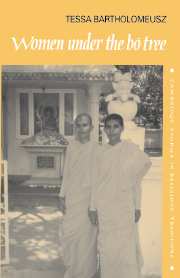Book contents
- Frontmatter
- Contents
- Preface
- Acknowledgments
- Notes on pronunciation
- Dramatis personae
- PART I
- PART II
- 5 The institutionalization of tradition: the early twentieth century and the lay nun
- 6 The lay nun in transitional Ceylon
- 7 The dasa sil mātā in contemporary Sri Lanka
- 8 Novitiates, western lay nuns, and cave dwellers
- 9 The Sri Lankan Bhikkhuī Saňgha: trends and reflections
- Epilogue: Women under the Bō tree
- Appendices
- Notes
- Select bibliographies
- Index and glossary
8 - Novitiates, western lay nuns, and cave dwellers
Published online by Cambridge University Press: 05 November 2011
- Frontmatter
- Contents
- Preface
- Acknowledgments
- Notes on pronunciation
- Dramatis personae
- PART I
- PART II
- 5 The institutionalization of tradition: the early twentieth century and the lay nun
- 6 The lay nun in transitional Ceylon
- 7 The dasa sil mātā in contemporary Sri Lanka
- 8 Novitiates, western lay nuns, and cave dwellers
- 9 The Sri Lankan Bhikkhuī Saňgha: trends and reflections
- Epilogue: Women under the Bō tree
- Appendices
- Notes
- Select bibliographies
- Index and glossary
Summary
INTRODUCTION
Lay nuns who represent the contemporary mainstream tradition of female Buddhist renunciation in Sri Lanka, such as Sumettā and Dhammādinnā, live in groups and village settings. As we have seen, they devote their lives to study and pūjā, as well as to service. In this chapter, I offer an account of lay nuns whose interpretation of female renunciation sets them apart from most women who have donned the ochre robe. While they do not typify contemporary female renunciation, their contribution and impact is influential. I also explore both the attitudes of monks toward lay nuns and lay nuns' opinions of their own tradition. All the lay nuns I interviewed, whether they conform to the mainstream tradition of female renunciation or not, see themselves as Theravā dins whose destiny it is to embody true Buddhism and protect its integrity.
Foremost among the renunciants I introduce in this chapter are Americans, Europeans, and an Australian who have all converted to Buddhism and donned the ochre robe. Their biographies suggest that their background and outlook are radically different from the Sinhala lay nuns we met in chapter 7. Though there are only a handful of western lay nuns in Sri Lanka, they are very prominent in the cities and villages around the island. Such women are often vociferous in their support of the tradition of Theravādin female renunciation and they, rather than Sinhala lay nuns, have become its spokespersons.
Others who do not typify the contemporary tradition of female renunciation in Sri Lanka are the cave-dwelling lay nuns of the Ruhunu National Forest.
- Type
- Chapter
- Information
- Women under the Bo TreeBuddhist nuns in Sri Lanka, pp. 156 - 180Publisher: Cambridge University PressPrint publication year: 1994

